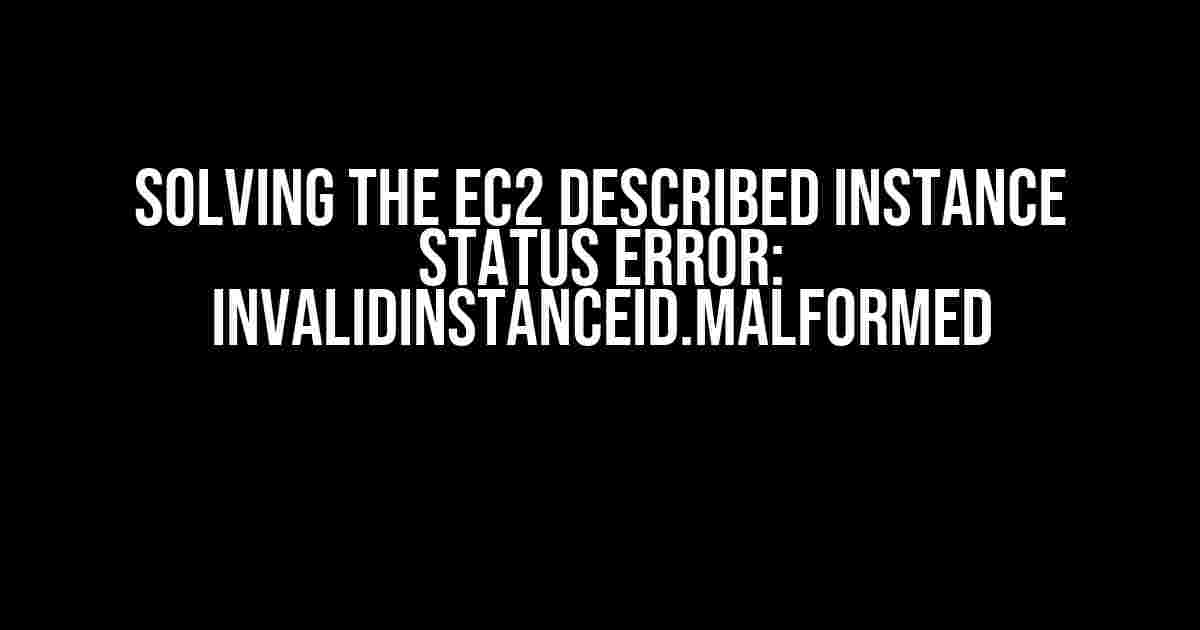Are you stuck with the frustrating “EC2-describe-instance-status InvalidInstanceID.Malformed” error? Don’t worry, you’re not alone! This error can be a real showstopper, but fear not, dear AWS enthusiast, for we’ve got you covered. In this comprehensive guide, we’ll dive into the world of EC2 instance statuses, explore the causes of this error, and provide you with step-by-step solutions to get you back on track.
What is EC2-Describe-Instance-Status?
Before we dive into the error, let’s take a step back and understand what EC2-Describe-Instance-Status is all about. The EC2-Describe-Instance-Status command is a part of the AWS CLI (Command Line Interface) that allows you to retrieve the status of one or more Amazon Elastic Compute Cloud (EC2) instances.
aws ec2 describe-instance-status --instance-ids i-1234567890abcdef0This command is useful for checking the current state of your instances, such as whether they’re running, pending, shutting down, or stuck in a perpetual state of limbo.
The Error: InvalidInstanceID.Malformed
Now, let’s talk about the error at hand. When you run the EC2-Describe-Instance-Status command, you might encounter an error message that looks something like this:
An error occurred (InvalidInstanceID.Malformed) when calling the DescribeInstanceStatus operation: Invalid id: "i-1234567890abcdef0"This error usually occurs when there’s an issue with the instance ID you’re trying to query. But don’t worry, we’ll explore the possible causes and solutions in detail.
Causes of the Error
So, what could be causing this error? Here are some possible reasons:
- Typo in the Instance ID: A single misplaced character or incorrect instance ID can trigger this error.Invalid or Non-Existent Instance ID: If the instance ID doesn’t exist or is invalid, you’ll get the InvalidInstanceID.Malformed error.
- AWS Region Mismatch: Make sure you’re using the correct AWS region for your instance. If the region doesn’t match, you’ll get an error.
- Instance ID Format: The instance ID format should be in the correct format (i.e., “i-” followed by 8 hexadecimal characters).
- Permissions and Access Issues: Ensure that your AWS credentials have the necessary permissions to describe instance statuses.
Solutions to the Error
Now that we’ve explored the possible causes, let’s dive into the solutions!
Solution 1: Verify the Instance ID
Double-check the instance ID for any typos or errors. Make sure it’s in the correct format (i.e., “i-” followed by 8 hexadecimal characters). You can do this by:
- Logging into the AWS Management Console and checking the instance ID in the EC2 dashboard.
- Using the AWS CLI command
aws ec2 describe-instances --instance-ids i-1234567890abcdef0to verify the instance ID.
Solution 2: Check the AWS Region
Ensure that you’re using the correct AWS region for your instance. You can do this by:
- Logging into the AWS Management Console and checking the region in the top-right corner.
- Using the AWS CLI command
aws ec2 describe-instances --instance-ids i-1234567890abcdef0 --region us-west-2to specify the region.
| AWS Region | Region Code |
|---|---|
| US East (N. Virginia) | us-east-1 |
| US West (Oregon) | us-west-2 |
| EU (Ireland) | eu-west-1 |
| AP (Tokyo) | ap-northeast-1 |
Solution 3: Check Permissions and Access
Ensure that your AWS credentials have the necessary permissions to describe instance statuses. You can do this by:
- Verifying that your IAM user or role has the necessary permissions (e.g.,
ec2:DescribeInstanceStatus). - Using the AWS CLI command
aws sts get-caller-identityto check your AWS credentials and permissions.
Best Practices to Avoid the Error
To avoid the “EC2-describe-instance-status InvalidInstanceID.Malformed” error in the future, follow these best practices:
- Store instance IDs securely: Keep your instance IDs in a secure location, such as an encrypted text file or a secrets manager.
- Use consistent naming conventions: Use consistent naming conventions for your instances to avoid confusion.
- Verify instance IDs before use: Always verify the instance ID before using it in an AWS CLI command or SDK.
- Test AWS CLI commands: Test AWS CLI commands in a non-production environment before running them in production.
Conclusion
In this comprehensive guide, we’ve explored the world of EC2 instance statuses, causes of the “EC2-describe-instance-status InvalidInstanceID.Malformed” error, and provided you with step-by-step solutions to overcome this hurdle. By following the best practices outlined above, you’ll be well on your way to avoiding this error and mastering the art of EC2 instance management.
Remember, whether you’re a seasoned AWS pro or just starting out, errors are an inevitable part of the learning process. The key is to stay calm, troubleshoot methodically, and seek help when needed. Happy cloud computing!
Frequently Asked Question
Get answers to the most common questions about “ec2-describe-instance-status InvalidInstanceID.Malformed” error!
What does “ec2-describe-instance-status InvalidInstanceID.Malformed” mean?
This error message indicates that the instance ID you provided is not in the correct format. It’s like trying to put a square peg into a round hole – it just won’t fit! Double-check your instance ID and make sure it’s in the correct format, and then try again.
Why does Amazon EC2 return “InvalidInstanceID.Malformed”?
Amazon EC2 returns this error when it encounters an instance ID that doesn’t conform to the expected format. This can happen if the instance ID is missing, contains special characters, or has the wrong number of characters. Make sure to provide a valid instance ID in the correct format, and Amazon EC2 will happily provide the instance status.
How do I fix “ec2-describe-instance-status InvalidInstanceID.Malformed” error?
To fix this error, simply verify that your instance ID is correct and in the right format. You can check your instance ID in the Amazon EC2 console or by using the AWS CLI command “aws ec2 describe-instances –instance-ids
Can I use “ec2-describe-instance-status” with a region specified?
Yes, you can use “ec2-describe-instance-status” with a region specified. In fact, it’s a good practice to specify the region to ensure you’re getting the correct instance status. For example, you can use the command “ec2-describe-instance-status –region us-west-2 –instance-ids
What are some common mistakes that lead to “ec2-describe-instance-status InvalidInstanceID.Malformed”?
Some common mistakes that lead to this error include typing the instance ID incorrectly, using a region-specific instance ID in a different region, or providing an instance ID that doesn’t exist. Make sure to double-check your instance ID and region before running the command, and you’ll be less likely to encounter this error.


